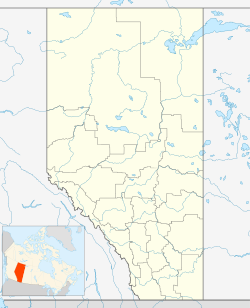Lac La Biche, Alberta
| Lac La Biche | |
|---|---|
| Hamlet | |

Main street
|
|
| Motto: Forestry Capital of Canada | |
| Location of Lac La Biche in Alberta | |
| Coordinates: 54°46′13″N 111°58′45″W / 54.77028°N 111.97917°WCoordinates: 54°46′13″N 111°58′45″W / 54.77028°N 111.97917°W | |
| Country |
|
| Province |
|
| Region | Northern Alberta |
| Census division | 12 |
| Municipal district | Lac La Biche County |
| Founded | October 4, 1798 |
| Dissolved | August 1, 2007 |
| Government | |
| • Mayor | Omer Moghrabi |
| • Governing body |
Lac La Biche County Council
|
| Area (2011) | |
| • Total | 6.20 km2 (2.39 sq mi) |
| Elevation | 560 m (1,840 ft) |
| Population (2011) | |
| • Total | 2,520 |
| • Density | 407.8/km2 (1,056/sq mi) |
| • Population centre | 2,544 |
| • Population centre density | 410.6/km2 (1,063/sq mi) |
| Time zone | MST (UTC−7) |
| • Summer (DST) | MDT (UTC−6) |
| Postal code span | T0A 2C0-T0A 2C2 |
| Area code(s) | -1+780 |
| Highways |
Highway 55 Highway 36 Highway 881 |
| Waterway | Lac la Biche |
| Website | laclabichecounty.com |
| Official name | Notre Dame des Victoires / Lac La Biche Mission National Historic Site of Canada |
| Designated | 1989 |
Lac La Biche is a hamlet in Alberta, Canada, within Lac La Biche County. It is located approximately 220 kilometres (140 mi) northeast of the provincial capital of Edmonton, on the southern shore of Lac la Biche. Previously incorporated as a town, Lac La Biche amalgamated with Lakeland County to form Lac La Biche County on August 1, 2007.
Lac La Biche was on the historical voyageur route that linked the Athabaskan region to Hudson Bay. David Thompson and George Simpson used the fur trade route via the Beaver River from the main Methye Portage route that reached the Athabasca River. David Thompson was the first known European to record his sojourn on Lac La Biche. Thompson, who referred to the lake as Red Deers Lake, arrived October 4, 1798 and built a trading post, now known as Lac La Biche, and overwintered there. He entered copious notes in his diary on the Nahathaway (the Cree), their customs, traditions, and the Western Forest Land, including the large supply of whitefish and beaver.
"The French-speaking element, mostly from Red River, coalesced around the Oblate mission that was established in 1853. It formed a community that was tightly knit, even though the influence of the church lessened and the trend was towards marrying out and establishing nuclear families. Living was largely off the land; logging and road work provided intermittent wage labour. Many of the adults were trilingual, speaking French and Cree as well as English."
The Hudson's Bay Post at Lac La Biche was looted on April 26, 1885 during the Northwest Rebellion by members of Big Bear's band. Their plan to loot the nearby Roman Catholic Mission was stopped by the local Cree and Métis population. Métis Scrip Records show many residents of the area were awarded scrip by the Government of Canada from 1885 until the 1920s.
...
Wikipedia

